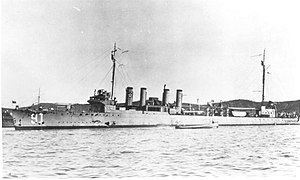 USS Harding as a seaplane tender at Guantanamo Bay, Cuba, circa 1920–1921
| |
| History | |
|---|---|
| Name | Harding |
| Namesake | Seth Harding |
| Builder | Union Iron Works, San Francisco, California |
| Laid down | 12 February 1918 |
| Launched | 4 July 1918 |
| Commissioned | 24 January 1919 |
| Decommissioned | 1 July 1922 |
| Stricken | 7 January 1936 |
| Fate | Sold for scrap, 8 September 1936 |
| General characteristics | |
| Class and type | Wickes-class destroyer |
| Displacement | 1,060 long tons (1,080 t) |
| Length | 315 ft 5 in (96.1 m) |
| Beam | 31 ft 8 in (9.7 m) |
| Draft | 8 ft 6 in (2.6 m) |
| Speed | 35 knots (65 km/h) |
| Complement | 100 officers and enlisted |
| Armament |
|
USS Harding (DD-91) was a Wickes-class destroyer in the United States Navy during World War I. She was the first ship named in honor of Seth Harding.
Launched in 1918, she undertook training exercises off the East Coast of the United States sporadically for several years. In 1919, she escorted a major transatlantic flight of Curtiss NC seaplane. Later that year, she was selected to be converted into a seaplane tender, and was then used to support naval aviator training off Naval Air Station Pensacola. She took one trip to Veracruz with emergency medical supplies, and was also on hand during aircraft bombing tests against decommissioned German ships, including the sinking of SMS Ostfriesland. She was decommissioned in 1922 and sold for scrapping in 1936.